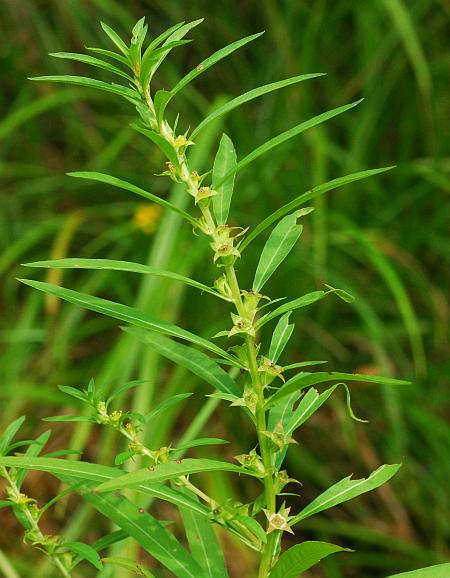Ludwigia polycarpa Short & R. Peter
Water Purslane

Native
CC = 6
CW = -5
MOC = 29
© SRTurner
Ludwigia polycarpa Short & R. PeterWater Purslane | |
 |
Native CC = 6 CW = -5 MOC = 29 |
© SRTurner |
|
Family - Onagraceae Habit - Fibrous-rooted perennial forb. Stem - Stems to 60 cm, ascending to erect, sparsely pubescent along stem angles. Plants perennial on fibrous roots, with stolons present.
Leaf - Leaves alternate, on short, narrowly winged petioles. Blades to 11 cm, narrowly elliptic, long-tapered at base, sharply pointed at tips, appearing entire but with minute glandular teeth. Venation pinnate, with distal ends of lateral veins fused to marginal vein. Stipules present, minute.
Flowers - Flowers axillary, sessile or nearly so, with narrowly lanceolate bractlets to 6.5 mm long. Sepals 4, 2.5-4.5 mm long, triangular-ovate, tapered to a slender, sharply pointed tip. Petals absent. Stamens 4, the filaments yellowish green. Pistil 1, with 4-locular inferior ovary. Stigma capitate, lobed.
Fruits - 4-7 mm long, 2.5-5.0 mm wide (less than 2 times as long as wide), bluntly 4-angled in cross-section, glabrous or nearly so, dehiscing irregularly by deterioration of the walls. Seeds 0.5-0.6 mm long, free from the fruit tissue at maturity, the surface light brown to yellowish brown, appearing smooth, glabrous.
Flowering - June - September. Habitat - Riverbanks, margins of ponds and sloughs, swamps, bottomland prairies. Origin - Native to the U.S. Lookalikes - L. palustris, L. microcarpa, and others. The plant is distinctive when examined closely, but easily mistaken at a glance for nondescript vegetative stems. Other info. - This species of the normally showy genus Ludwigia is actually inconspicuous and easy to overlook, due to its small flowers which lack petals. The appearance is reminiscent of a plant which has already gone to fruit. Close inspection may reveal flowers with fresh anthers shedding pollen. The species epithet 'polycarpa' means 'many fruits.' The plant is mostly found in the northern half of the state. Beyond Missouri its range occurs mostly in the upper U.S. Midwest and parts of Canada. Photographs taken at Indian Camp Creek Park, St. Charles County, MO, 9-7-2015 (SRTurner). |